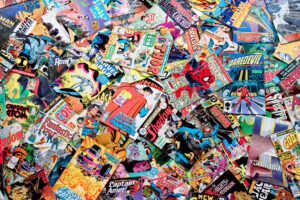 The Unbeatable Squirrel Girl #7 — Writer: Ryan North; Art: Erica Henderson; Colors: Rico Renzi with Erica Henderson
The Unbeatable Squirrel Girl #7 — Writer: Ryan North; Art: Erica Henderson; Colors: Rico Renzi with Erica Henderson
Moon Girl and Devil Dinosaur #6 — Writers: Brandon Montclare and Amy Reeder; Art: Natacha Bustos; Colors: Tamra Bonvillain
Ms. Marvel #6 — Writer: G. Willow Wilson; Art: Nico Leon; Colors: Ian Herring
Patsy Walker, A.K.A. Hellcat #5 — Writer: Kate Leth; Art: Brittney L. Williams; Colors: Megan Wilson
Spider-Woman #6 — Writer: Dennis Hopeless; Art: Joelle Jones; Colors: Rachelle Rosenberg
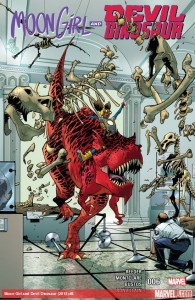 Women rule at both Marvel and DC this week, with many of the best books sporting female leads. Witness The Unbeatable Squirrel Girl #7, which provides a change-of-pace find-your-own-adventure story — the comic’s cover is meant to look like an old paperback from that ’90s craze — and does it with smarts, cuteness and more than a little snarky humor (the bad guy, the old Spider-Man villain Swarm — who’s, um, made out of bees — is the perfect choice for Doreen and company: animal-based, off-beat and kind of dumb, but surprisingly hard to beat). Between North’s clever, funny, warmly-human writing and Henderson’s precise, cartoony art (although she can draw in other styles too — look at that cover), this continues to be one of the best books on the stands; if you haven’t tried it, pick this up — or start with one of the trade collections — and see what you’ve been missing. Moon Girl and Devil Dinosaur gets to the end of its first arc this
Women rule at both Marvel and DC this week, with many of the best books sporting female leads. Witness The Unbeatable Squirrel Girl #7, which provides a change-of-pace find-your-own-adventure story — the comic’s cover is meant to look like an old paperback from that ’90s craze — and does it with smarts, cuteness and more than a little snarky humor (the bad guy, the old Spider-Man villain Swarm — who’s, um, made out of bees — is the perfect choice for Doreen and company: animal-based, off-beat and kind of dumb, but surprisingly hard to beat). Between North’s clever, funny, warmly-human writing and Henderson’s precise, cartoony art (although she can draw in other styles too — look at that cover), this continues to be one of the best books on the stands; if you haven’t tried it, pick this up — or start with one of the trade collections — and see what you’ve been missing. Moon Girl and Devil Dinosaur gets to the end of its first arc this  issue, and it should make a killer trade, too — its protagonist is equal parts adorable genius, awkward preteen girl and take-no-crap adventurer, and this first story has done a masterful job of establishing her relationship with her big red co-star, setting up her quest, and showing readers why they should be rooting for her — which makes its combination of satisfying resolution and startling cliffhanger ending all the better. Great story, attractive art: this is a low-selling title that deserves a wide, enthusiastic audience, and here’s hoping that it gets it. One sign of hope is that similar books with smart, spunky female leads have been doing well, especially with newer Millennial-type readers: we’ve already covered Squirrel Girl, and then there’s Ms. Marvel, also a hit — especially in digital and trade-collection versions. This week’s latest issue, which is also the conclusion of an arc, shows why: there’s slapstick humor, danger, character interaction with both Kamala’s family
issue, and it should make a killer trade, too — its protagonist is equal parts adorable genius, awkward preteen girl and take-no-crap adventurer, and this first story has done a masterful job of establishing her relationship with her big red co-star, setting up her quest, and showing readers why they should be rooting for her — which makes its combination of satisfying resolution and startling cliffhanger ending all the better. Great story, attractive art: this is a low-selling title that deserves a wide, enthusiastic audience, and here’s hoping that it gets it. One sign of hope is that similar books with smart, spunky female leads have been doing well, especially with newer Millennial-type readers: we’ve already covered Squirrel Girl, and then there’s Ms. Marvel, also a hit — especially in digital and trade-collection versions. This week’s latest issue, which is also the conclusion of an arc, shows why: there’s slapstick humor, danger, character interaction with both Kamala’s family 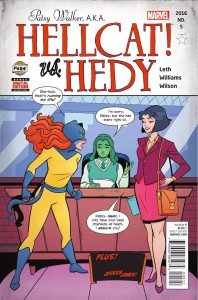 (her brother’s about to be married) and her superhero cohorts (both Captain Marvel and Iron Man show up to give advice, since she’s been in the Avengers for a while now), and a theme about juggling responsibilities that’s universal, but would especially appeal to the high-school-age readers who form the sweet spot for this book’s audience. Charming art, and a story that combines action, humor and a subtle push for diversity (this comic has probably done more to make Muslims seem “normal,” especially for its younger readers, than any nonfiction lecture could) create a winning combination, and a heroine who’s relatable and real. Hellcat doesn’t seem as real — like Squirrel Girl, the cartoony style and winking humor in the script signal that nothing permanently bad is going to happen to anyone — but the candy-colored art by Brittney
(her brother’s about to be married) and her superhero cohorts (both Captain Marvel and Iron Man show up to give advice, since she’s been in the Avengers for a while now), and a theme about juggling responsibilities that’s universal, but would especially appeal to the high-school-age readers who form the sweet spot for this book’s audience. Charming art, and a story that combines action, humor and a subtle push for diversity (this comic has probably done more to make Muslims seem “normal,” especially for its younger readers, than any nonfiction lecture could) create a winning combination, and a heroine who’s relatable and real. Hellcat doesn’t seem as real — like Squirrel Girl, the cartoony style and winking humor in the script signal that nothing permanently bad is going to happen to anyone — but the candy-colored art by Brittney  Williams (who’s also doing Goldie Vance) is a plus, and Kate Leth imbues her former-model superhero with charm, optimism and a lot of fun. Spider-Woman, meanwhile, is in the middle of a crossover between the other distaff/arachnid books, Spider-Gwen and Silk, which stalls some of the momentum from its Jessica-gives-birth first big story. However, being a mom means that she’s a lot more take-charge and grown-up now, especially compared to the two teens she’s paired with; her Kill Bill-inspired encounter with another mom, and her calm, determined and practical response to crises, makes her a mentor and a leader, and it’s a welcome direction for a character who’s always been a little too reactive to events.
Williams (who’s also doing Goldie Vance) is a plus, and Kate Leth imbues her former-model superhero with charm, optimism and a lot of fun. Spider-Woman, meanwhile, is in the middle of a crossover between the other distaff/arachnid books, Spider-Gwen and Silk, which stalls some of the momentum from its Jessica-gives-birth first big story. However, being a mom means that she’s a lot more take-charge and grown-up now, especially compared to the two teens she’s paired with; her Kill Bill-inspired encounter with another mom, and her calm, determined and practical response to crises, makes her a mentor and a leader, and it’s a welcome direction for a character who’s always been a little too reactive to events.
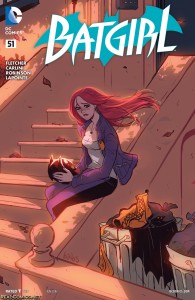 Batgirl #51 — Writer: Brenden Fletcher; Art: Eleonara Carlinni, Minkyu Jung, and Roger Robinson; Colors: Serge LaPointe
Batgirl #51 — Writer: Brenden Fletcher; Art: Eleonara Carlinni, Minkyu Jung, and Roger Robinson; Colors: Serge LaPointe
Black Canary #11 — Writer: Brenden Fletcher; Art: Sandy Jarrell; Colors: Lee Loughridge
Harley Quinn #27 — Writers: Amanda Connor and Jimmy Palmiotti; Art: John Timms; Colors: Alex Sinclair
DC’s own “girl” books — Batgirl is a coda to last issue’s ongoing-story climax, and, while there’s action, it’s more of a fond farewell to the “Burnside” setup and supporting cast, as Barbara decides to take some time off and 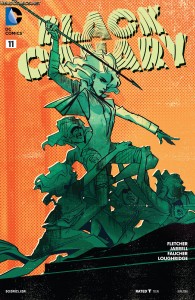 Fletcher sets things up for the next creative team after “Rebirth.” There’s one more issue to go of this volume, though, and considering that this one involves a crossover with Gotham Academy and the return of both Black Canary and Vixen, it promises to be a good conclusion. The only quibble is that Babs Tarr doesn’t do the interior art, but her cover, with Barbara sitting on a stoop looking sad and those yellow Doc Martens boots on the top of a trash can, says good-bye to a groundbreaking series about as well as anything could. Black Canary is winding down, too, with one more issue to go, as Dinah battles supernatural Eurotrash connected to her long-gone mother. It’s a partial crossover with Batgirl, with
Fletcher sets things up for the next creative team after “Rebirth.” There’s one more issue to go of this volume, though, and considering that this one involves a crossover with Gotham Academy and the return of both Black Canary and Vixen, it promises to be a good conclusion. The only quibble is that Babs Tarr doesn’t do the interior art, but her cover, with Barbara sitting on a stoop looking sad and those yellow Doc Martens boots on the top of a trash can, says good-bye to a groundbreaking series about as well as anything could. Black Canary is winding down, too, with one more issue to go, as Dinah battles supernatural Eurotrash connected to her long-gone mother. It’s a partial crossover with Batgirl, with 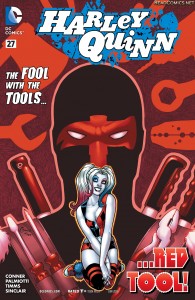 Barbara providing long-distance help and Vixen onhand (not a surprise, since both books are written by Fletcher), and Sandy Jarrell’s dramatic, impressionistic art delivers spooky, indy-tinged drama. Since this is the penultimate chapter of the series, things end badly for our heroine, but presumably they’ll work themselves out next month, too. Harley Quinn, DC’s best-selling woman character, offers our New York City-based semi-heroine fighting a parody of one of Marvel’s most dependable sellers, Deadpool (he’s called “Red Tool” here), and Connor and Palmiotti make him murderous, chauvinistic and a stalker with a crush on Harley; if you like one or both characters, this will probably be worth your time.
Barbara providing long-distance help and Vixen onhand (not a surprise, since both books are written by Fletcher), and Sandy Jarrell’s dramatic, impressionistic art delivers spooky, indy-tinged drama. Since this is the penultimate chapter of the series, things end badly for our heroine, but presumably they’ll work themselves out next month, too. Harley Quinn, DC’s best-selling woman character, offers our New York City-based semi-heroine fighting a parody of one of Marvel’s most dependable sellers, Deadpool (he’s called “Red Tool” here), and Connor and Palmiotti make him murderous, chauvinistic and a stalker with a crush on Harley; if you like one or both characters, this will probably be worth your time.
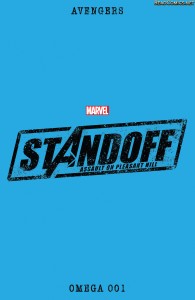 Standoff: Assault on Pleasant Hill Omega #1 (of 1) — Writer: Nick Spencer; Art: Daniel Acuna with Angel Unzueta; Colors: Daniel Acuna with Matt Wilso
Standoff: Assault on Pleasant Hill Omega #1 (of 1) — Writer: Nick Spencer; Art: Daniel Acuna with Angel Unzueta; Colors: Daniel Acuna with Matt Wilso
Doctor Strange: Last Days of Magic #1 (of 1) — Creators: Various
Doctor Strange #7 — Writer: Jason Aaron; Pencils/Colors: Chris Bachalo; Inks: Six Guys; Additional Colors: Tim Townsend
Two Marvel first issues, but both are really parts of ongoing series: Standoff, in fact, is the bookend conclusion of the “Pleasant Hill” story that’s been winding 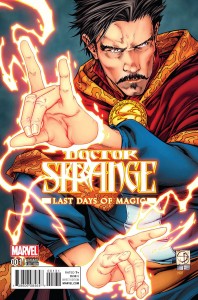 its way through the Avengers, S.H.I.E.L.D. and Captain America books for a couple of months. It kind of lands with a thud — all those tie-in issues, and what we’re left with after the dust settles and all the punches have been thrown is Bucky headlining a new Thunderbolts book in a few weeks (and mentoring the little-girl cosmic cube Kobik), and Steve Rogers re-powered, de-aged and back to being Captain America. This was pitched to readers as a preamble to this summer’s Civil War II, but it’s hard to see much connection, at least so far: lots of action here, but little payoff. Doctor Strange: Last Days of Magic piggybacks off of events in Doc’s own book, where an inter-dimensional race of badass wizard-busters has been going all Spanish Inquisition on Earth’s magic users. This special spotlights four of the mages who are playing key roles in the ongoing series:
its way through the Avengers, S.H.I.E.L.D. and Captain America books for a couple of months. It kind of lands with a thud — all those tie-in issues, and what we’re left with after the dust settles and all the punches have been thrown is Bucky headlining a new Thunderbolts book in a few weeks (and mentoring the little-girl cosmic cube Kobik), and Steve Rogers re-powered, de-aged and back to being Captain America. This was pitched to readers as a preamble to this summer’s Civil War II, but it’s hard to see much connection, at least so far: lots of action here, but little payoff. Doctor Strange: Last Days of Magic piggybacks off of events in Doc’s own book, where an inter-dimensional race of badass wizard-busters has been going all Spanish Inquisition on Earth’s magic users. This special spotlights four of the mages who are playing key roles in the ongoing series: 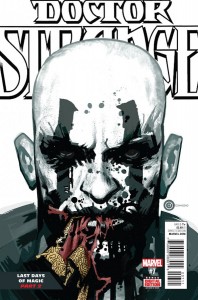 “Doctor Voodoo,” written by Gerry Duggan and drawn by Danilo Beyruth, with colors by Dan Brown; “The Wu,” with script by James Robinson, art by Mike Perkins and colors by Andy Troy; and a framing sequence by regular Strange writer Jason Aaron, artist Leonardo Romero and colorist Jordie Bellaire, which involves both Mexican and Russian masters of the mystic arts. The comic’s an effective way of filling us in on these people and their abilities without having to slow the regular book down; after reading it, then tackle Doctor Strange #7, which picks up the main story again with magic almost gone and our heroes in dire straits; as always, its attractions are both the high-stakes Aaron script and the pitch-perfect, magical art by Chris Bachalo.
“Doctor Voodoo,” written by Gerry Duggan and drawn by Danilo Beyruth, with colors by Dan Brown; “The Wu,” with script by James Robinson, art by Mike Perkins and colors by Andy Troy; and a framing sequence by regular Strange writer Jason Aaron, artist Leonardo Romero and colorist Jordie Bellaire, which involves both Mexican and Russian masters of the mystic arts. The comic’s an effective way of filling us in on these people and their abilities without having to slow the regular book down; after reading it, then tackle Doctor Strange #7, which picks up the main story again with magic almost gone and our heroes in dire straits; as always, its attractions are both the high-stakes Aaron script and the pitch-perfect, magical art by Chris Bachalo.
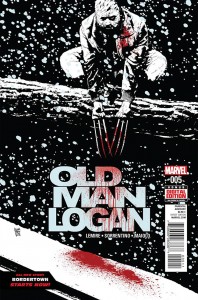 Old Man Logan #5 — Writer: Jeff Lemire; Art: Andrea Sorrentino; Colors: Marcelo Maiolo
Old Man Logan #5 — Writer: Jeff Lemire; Art: Andrea Sorrentino; Colors: Marcelo Maiolo
Amazing Spider-Man #11 — Writer: Dan Slott; Pencils: Giuseppe Camuncoli; Inks: Cam Smith; Colors: Marte Gracia
International Iron Man #2 — Writer: Brian Michael Bendis; Art: Alex Maleev; Colors: Paul Mounts
 Ultimates #6 — Writer: Al Ewing; Art/Colors: Christian Ward
Ultimates #6 — Writer: Al Ewing; Art/Colors: Christian Ward
A quartet of other Marvel books: Old Man Logan is beginning a new storyline, with Logan’s book now up to date with his role in the current Extraordinary X-Men, although Lemire is still mixing time periods, with flashbacks to his post-apocalyptic days; Sorrentino’s art is a good match for the violent, shadowy goings-on, as a look at the cover will confirm. Amazing Spider-Man 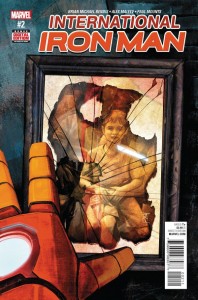 concludes the globe-trotting “Scorpio” arc, with Slott and Camuncoli mixing action, subplots and quips with their usual skill, behind a striking Alex Ross cover. International Iron Man, in its second issue, continues its flashback to a college-age Tony encountering an Elektra-like girlfriend, interspersed with his present-day confrontation with her as a terrorist; as always, it’s worth it for the Bendis dialogue, the way he backs Stark into a seemingly-no-way-out cliffhanger, and for Alex Maleev’s cool-looking illustrations. Ultimates is mostly an outside-
concludes the globe-trotting “Scorpio” arc, with Slott and Camuncoli mixing action, subplots and quips with their usual skill, behind a striking Alex Ross cover. International Iron Man, in its second issue, continues its flashback to a college-age Tony encountering an Elektra-like girlfriend, interspersed with his present-day confrontation with her as a terrorist; as always, it’s worth it for the Bendis dialogue, the way he backs Stark into a seemingly-no-way-out cliffhanger, and for Alex Maleev’s cool-looking illustrations. Ultimates is mostly an outside-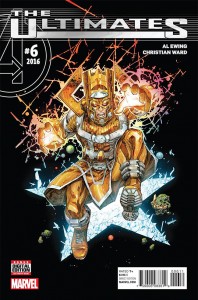 the-universe conversation between Galactus (who’s now a life-force-giving entity who heals planets instead of eating them, which means he at least gets to ditch his purple wardrobe) and the Molecule Man; if you like Jim Starlin-type cosmic-level Marvel Universe stuff, including what actually happened at the end of Secret Wars, whether we’re in the seventh or eighth iteration of the universe, and what happens if you punch Order in the face, then Al Ewing’s got a lot here for you, and guest artist Christian Ward’s exaggerated style and bold color palate keep it both good-looking and, especially with Owen Reese, suitable eerie.
the-universe conversation between Galactus (who’s now a life-force-giving entity who heals planets instead of eating them, which means he at least gets to ditch his purple wardrobe) and the Molecule Man; if you like Jim Starlin-type cosmic-level Marvel Universe stuff, including what actually happened at the end of Secret Wars, whether we’re in the seventh or eighth iteration of the universe, and what happens if you punch Order in the face, then Al Ewing’s got a lot here for you, and guest artist Christian Ward’s exaggerated style and bold color palate keep it both good-looking and, especially with Owen Reese, suitable eerie.
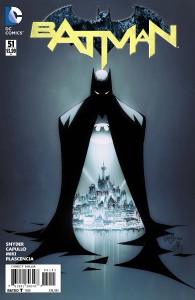 Batman #51 — Writer: Scott Snyder; Pencils: Greg Capullo; Inks: Danny Miki; Colors: FCO Plascencia
Batman #51 — Writer: Scott Snyder; Pencils: Greg Capullo; Inks: Danny Miki; Colors: FCO Plascencia
DKIII: The Master Race #4 (of 8 ) — Story by Frank Miller and Brian Azzarello; Pencils: Adam Kubert; Inks: Klaus Janson; Colors: Brad Anderson
Just two DC books, both involving Batman (but, remember, I already covered three of their other books earlier), with Batman #51 being a quiet, done-in-one tale about Gotham experiencing a blackout, and Batman investigating the cause; it gives Snyder a chance to look in on most of the cast, both good and bad, and establish both the current status quo and the groundwork for future stories; it’s also a gift to Capullo, who gets a number of night-shrouded Gotham 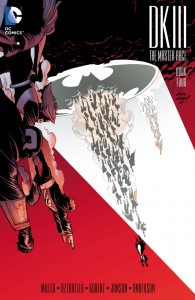 cityscapes to draw, including a last-page splash that would make a great poster. DK III reaches its halfway point with Earth under siege by a big bunch of Kryptonian fundamentalists, who take out the Man of Steel easily (with help from his daughter) and then demand Batman’s head; it’s fine for what it is, although like many Azzarello scripts it’s a collection of dramatic, cinematic bits that adds up to less than the sum of its parts. The insert comic is written by Azzarello and drawn by Miller, and features Batgirl (Carrie in a new identity) battling most of Gotham City to get to the pier and deliver some Maguffiny thing to a guest star who should have been obvious from “pier”; it’s Miller doing all-out street-fighting action, which is still a lot of fun to see.
cityscapes to draw, including a last-page splash that would make a great poster. DK III reaches its halfway point with Earth under siege by a big bunch of Kryptonian fundamentalists, who take out the Man of Steel easily (with help from his daughter) and then demand Batman’s head; it’s fine for what it is, although like many Azzarello scripts it’s a collection of dramatic, cinematic bits that adds up to less than the sum of its parts. The insert comic is written by Azzarello and drawn by Miller, and features Batgirl (Carrie in a new identity) battling most of Gotham City to get to the pier and deliver some Maguffiny thing to a guest star who should have been obvious from “pier”; it’s Miller doing all-out street-fighting action, which is still a lot of fun to see.
 Saga #36 — Writer: Brian K. Vaughan; Art/Colors: Fiona Staples
Saga #36 — Writer: Brian K. Vaughan; Art/Colors: Fiona Staples
Sex Criminals #15 — Writer: Matt Fraction; Art/Colors: Chip Zdarsky
Velvet #14 — Writer: Ed Brubaker; Art: Steve Epting; Colors: Elizabeth Breitweiser
Four Eyes: Hearts of Fire #4 (0f 4) — Writer: Joe Kelly; Art/Colors: Max Fiumara
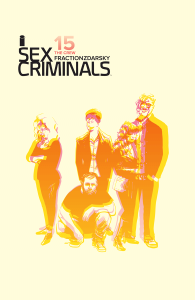 Injection #9 — Writer: Warren Ellis; Art: Declan Shalvey; Colors: Jordie Belllaire
Injection #9 — Writer: Warren Ellis; Art: Declan Shalvey; Colors: Jordie Belllaire
Outcast #18 — Writer: Robert Lirkman; Art: Paul Azeceta; Colors: Elizabeth Breitweiser
Circuit-Breaker #2 (of 5) — Writer: Kevin McCarthy; Art: Kyle Baker; Colors: Baker with Mindy Steffen
Over the Garden Wall #1 — (Lead Story): Writer/Artist: Jim Campbell with Danielle Burgos (Second Story): 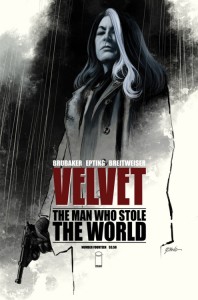 Writer: Amalia Levari; Art: Cara McGee
Writer: Amalia Levari; Art: Cara McGee
Rick and Morty #13 — Writer: Tom Fowler; Art: CJ Cannon; Colors: Ryan Hill
All the indy books — and quickly, since there are a lot of them. Saga wraps up its current volume; Vaughan and Staples offer the, for them, normal combination of excellent art and character-rich, well-constructed story. They’ve got a system that a lot of creator-owned books are starting to follow — six issues, a trade collection, and  then a break to recharge before the next installments — so there won’t be new material for a couple of months, but they leave readers with a couple of hard-won feel-good moments for their cast (and us). Sex Criminals has been spending its last six issues or so establishing its large cast, too, and now is starting to pull all of them together and hit some turning points and payoffs; like Saga, it combines detailed, evocative art with writing that gives all its tagonists, pro- and an-, multiple dimensions and relatable motives. This isn’t an issue that
then a break to recharge before the next installments — so there won’t be new material for a couple of months, but they leave readers with a couple of hard-won feel-good moments for their cast (and us). Sex Criminals has been spending its last six issues or so establishing its large cast, too, and now is starting to pull all of them together and hit some turning points and payoffs; like Saga, it combines detailed, evocative art with writing that gives all its tagonists, pro- and an-, multiple dimensions and relatable motives. This isn’t an issue that 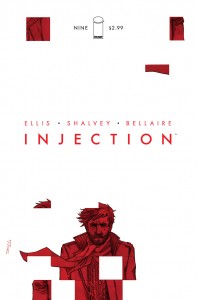 a brand-new reader would necessarily find exciting (that reader should start with the first trade collection and get to know everyone first), but for regulars it’s a good installment, and one that should increase anticipation for the next one. Velvet offers yet another solid, longstanding writer/artist combo in Brubaker and Epting; its got our super-spy heroine, framed and on the run, still managing to blackmail Gerald Ford and drug Richard Nixon (with truth serum, no less), so it really shouldn’t be missed. Four Eyes reaches the end of its second volume with its main characters, a
a brand-new reader would necessarily find exciting (that reader should start with the first trade collection and get to know everyone first), but for regulars it’s a good installment, and one that should increase anticipation for the next one. Velvet offers yet another solid, longstanding writer/artist combo in Brubaker and Epting; its got our super-spy heroine, framed and on the run, still managing to blackmail Gerald Ford and drug Richard Nixon (with truth serum, no less), so it really shouldn’t be missed. Four Eyes reaches the end of its second volume with its main characters, a 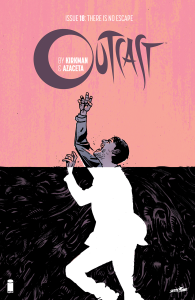 young dragon and its trainer, an equally-young boy, both fighting climactic battles against much-bigger, meaner foes. This gritty (but beautifully drawn) Depression-era alternate-Earth tale has grown in the telling, with Kelly and Fiumara collaborating to create a fully-realized world, with people (and at least one dragon) we care about and root for; it’s yet another series that’s going to yield a killer trade collection, with a story that has room for many more. Injection continues its Warren Ellis tale about a rogue computer/A.I. program that’s learned to simulate magic and gotten loose in the world,
young dragon and its trainer, an equally-young boy, both fighting climactic battles against much-bigger, meaner foes. This gritty (but beautifully drawn) Depression-era alternate-Earth tale has grown in the telling, with Kelly and Fiumara collaborating to create a fully-realized world, with people (and at least one dragon) we care about and root for; it’s yet another series that’s going to yield a killer trade collection, with a story that has room for many more. Injection continues its Warren Ellis tale about a rogue computer/A.I. program that’s learned to simulate magic and gotten loose in the world, 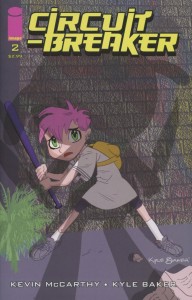 and the team of misfit researchers/adventurers who created it and are now trying to fight it; this issue has more character interaction and conversation than any big action set-pieces, but moves the story along nicely anyway — and it’s got that Declan Shalvey art to keep our interest. Outcast is another arc-closer, although its third volume ends with a cliffhanger instead of a resolution; this modern-day Exorcist-with-a-twist story is getting a TV version on Cinemax debuting in early June (the ads say “from Robert Kirkman, the creator of The Walking Dead”), so this might be a good time to get caught up on
and the team of misfit researchers/adventurers who created it and are now trying to fight it; this issue has more character interaction and conversation than any big action set-pieces, but moves the story along nicely anyway — and it’s got that Declan Shalvey art to keep our interest. Outcast is another arc-closer, although its third volume ends with a cliffhanger instead of a resolution; this modern-day Exorcist-with-a-twist story is getting a TV version on Cinemax debuting in early June (the ads say “from Robert Kirkman, the creator of The Walking Dead”), so this might be a good time to get caught up on 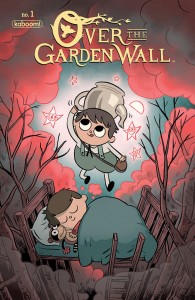 its quiet, creepy pleasures. Circuit Breaker continues its tribute to ’60s-era manga, particularly Astro Boy; the story hits a number of familiar beats, but does so well, and Kyle Baker art is always worth seeing: his Osamu Tezuka riffs here aren’t mere copies, but extensions and meditations on that old master’s style, and anyone who’s a fan of Japanese comics should be reading this book. Over The Garden Wall is a new ongoing book, based on the cult Cartoon Network cartoon mini-series but moving beyond it. Original creator Pat McHale isn’t involved in this first issue, but Jim Campbell, who drew previous comics
its quiet, creepy pleasures. Circuit Breaker continues its tribute to ’60s-era manga, particularly Astro Boy; the story hits a number of familiar beats, but does so well, and Kyle Baker art is always worth seeing: his Osamu Tezuka riffs here aren’t mere copies, but extensions and meditations on that old master’s style, and anyone who’s a fan of Japanese comics should be reading this book. Over The Garden Wall is a new ongoing book, based on the cult Cartoon Network cartoon mini-series but moving beyond it. Original creator Pat McHale isn’t involved in this first issue, but Jim Campbell, who drew previous comics 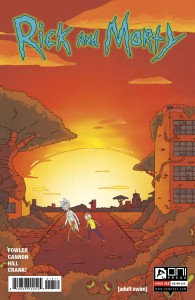 based on the show over McHale’s scripts, is both writer and artist on the lead story here, so it retains the flavor well. The second story doesn’t involve the kids, but is about a girl named Anna learning to live alone in the cartoon’s magical discovered world, the Unknown, and has the attraction of being by show writer Amalia Levari. Rick and Morty is based on another cult TV cartoon, this one from the Cartoon Network partner Adult Swim (or [adult swim], to use their style), and the comic does a good job of retaining its gonzo, snarky, violent and brightly-colored high-adventure tone. It’s an acquired taste, but once you’ve acquired it you’ll be hooked.
based on the show over McHale’s scripts, is both writer and artist on the lead story here, so it retains the flavor well. The second story doesn’t involve the kids, but is about a girl named Anna learning to live alone in the cartoon’s magical discovered world, the Unknown, and has the attraction of being by show writer Amalia Levari. Rick and Morty is based on another cult TV cartoon, this one from the Cartoon Network partner Adult Swim (or [adult swim], to use their style), and the comic does a good job of retaining its gonzo, snarky, violent and brightly-colored high-adventure tone. It’s an acquired taste, but once you’ve acquired it you’ll be hooked.

